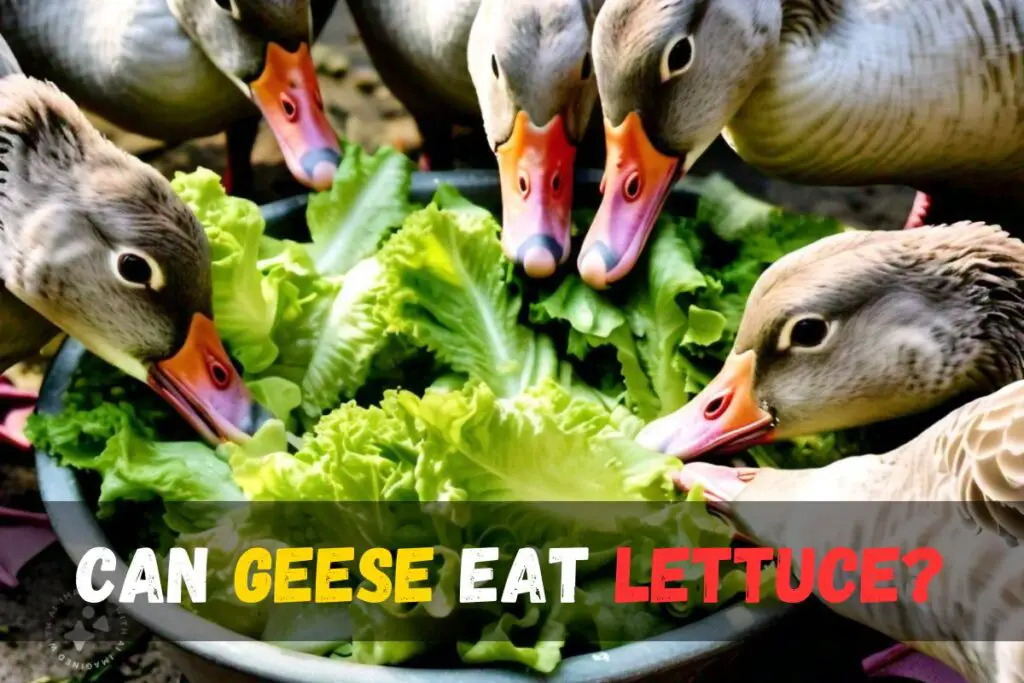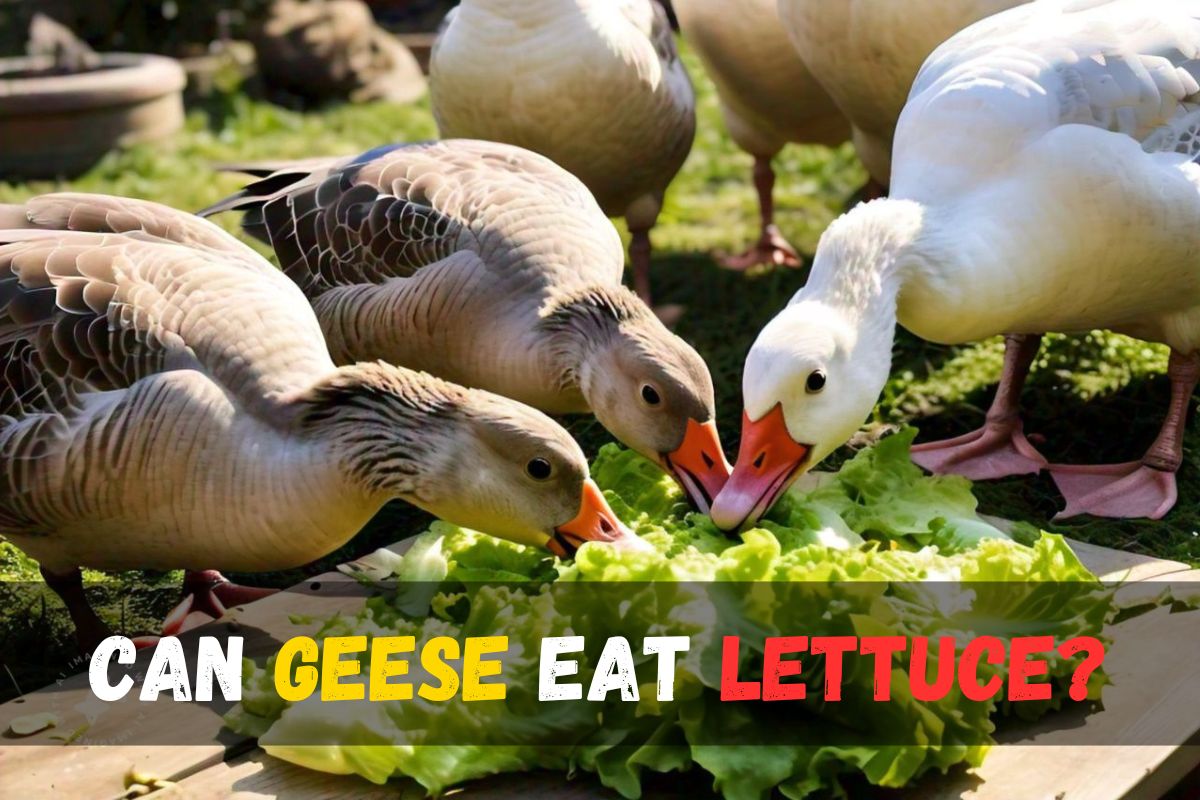My friend recently opened a goose farm and frequently sought my advice on caring for his birds. The other day, he asked me, “Can geese eat lettuce?” Given my experience and qualifications, I provided him with some sound advice. Recognizing the importance of sharing this knowledge with a broader audience, I wrote a detailed blog post to address this question comprehensively for others who might be curious. In this post, I will delve into the nutritional aspects of lettuce, the types that are most suitable for geese, and best practices for incorporating it into their diet to ensure their health and well-being.
Can geese eat lettuce?
Yes, geese can eat lettuce, a safe and nutritious addition to their diet. Lettuce, particularly the darker, leafy varieties like romaine, provides beneficial vitamins and minerals, including vitamins A and K and folate. It is a low-calorie food that can help keep geese hydrated due to its high water content. It’s important to avoid feeding them iceberg lettuce, as it offers minimal nutritional value and can lead to digestive issues if consumed in large quantities.

Can Geese Eat Tomatoes?
What Kind of Lettuce Can Geese Eat?
Romaine Lettuce
Romaine lettuce is famous for feeding geese due to its crisp texture and nutrient density. This type of lettuce is characterized by its long, sturdy leaves and is commonly found in home gardens and grocery stores. Geese generally find romaine lettuce appealing, and its structure makes it easy to handle and prepare. When feeding romaine lettuce to geese, it’s important to chop the leaves into manageable pieces to prevent choking and ensure easy digestion. Additionally, thorough washing is essential to remove any pesticides or contaminants that might be present.
Butterhead Lettuce
Butterhead lettuce, which includes varieties such as Bibb and Boston lettuce, is known for its soft, tender leaves and mild flavor. This type of lettuce is particularly well-suited for younger geese or those who might struggle with more challenging greens. Butterhead lettuce’s delicate texture makes it easy for geese to consume without much effort. As with other lettuces, washing and chopping butterhead lettuce before feeding it to geese is crucial to ensure their safety and health.
Leaf Lettuce
Leaf lettuce, available in red and green varieties, is another excellent option for geese. This type of lettuce features loose, ruffled leaves that are easy for geese to nibble on. Leaf lettuce is appreciated for its vibrant color and appealing texture, making it a favorite among many bird enthusiasts. Preparing leaf lettuce for geese involves similar steps to other lettuces: wash thoroughly to remove any chemicals and chop into small pieces to facilitate easy eating and digestion.
Lettuce to Avoid for Geese
Iceberg lettuce, despite being commonly available, is not recommended as a primary food source for geese. Its high water content and low nutrient density make it less beneficial than other lettuce types. While geese might enjoy the crispness of iceberg lettuce, it should only be offered occasionally and in small quantities. Overreliance on iceberg lettuce can lead to digestive issues and nutritional deficiencies, so it’s best to prioritize more nutrient-dense lettuces in their diet.
Can Geese Eat Corn?
How Much Lettuce Can Geese Eat?
Due to its high water content and relatively low nutritional value, lettuce should be offered as a treat rather than a staple. Overfeeding lettuce can lead to digestive issues, including diarrhea because geese require a balanced diet of fibers, proteins, and essential nutrients. Generally, a few leaves of lettuce per goose provided a couple of times a week, is sufficient to supplement their diet without causing harm. Always ensure the lettuce is fresh and free from pesticides or harmful chemicals. For optimal health, geese should primarily eat grasses, grains, and formulated waterfowl feeds, with lettuce and other greens serving as occasional treats.
Can Geese Eat Carrots?
How To Serve Lettuce To Geese?
Here’s a detailed guide on how to serve lettuce to geese, integrating essential SEO techniques to enhance the content’s visibility and readability.
Select Safe Varieties
Not all types of lettuce are ideal for geese. Opt for Romaine, Butterhead, or Green Leaf lettuce. Avoid iceberg lettuce, as it has low nutritional value and can cause digestive issues in large quantities.
Freshness Matters
Always choose fresh, crisp lettuce for your geese. Fresh lettuce provides better nutrition and is more palatable for the birds. Wilted or spoiled lettuce can harbor harmful bacteria and mold, posing a risk to the health of your geese. Fresh produce is critical to ensuring they receive the maximum benefits from their diet. Inspect the lettuce for any signs of spoilage, such as brown spots, slimy texture, or an off smell. Fresh lettuce should have a vibrant green color and firm, crunchy leaves.
Wash Thoroughly
Before serving, thoroughly rinse the lettuce under cold running water. This step is crucial to remove any residual pesticides, dirt, or bacteria that might be present on the leaves. Even organic lettuce can harbor contaminants that could harm your geese. Washing helps to ensure that the lettuce is clean and safe for consumption. Pay special attention to the base of the leaves, where dirt accumulates. After washing, gently shake off excess water or use a salad spinner to dry the leaves.
Chop into Manageable Pieces
Cut the lettuce into small, bite-sized pieces. This preparation step is essential for making the lettuce easier for geese to eat and reduces the risk of choking. Geese have relatively small beaks, so providing appropriately sized pieces ensures they can comfortably consume their food. Cut the pieces to be approximately one to two inches in size. This makes eating more accessible and encourages better digestion and nutrient absorption.
Remove the Core
The lettuce core can be challenging and fibrous, making it difficult for geese to digest. It’s best to discard the core and focus on the leafy parts, which are more tender and nutritious. The core lacks the same nutritional density as the leaves and can be a choking hazard. Cut around the core and dispose of it, then chop the remaining leaves into suitable pieces for feeding.
Offer in a Clean Bowl
Place the chopped lettuce in a clean bowl or trough for serving. Ensuring the feeding area is hygienic is crucial to prevent contamination and protect the health of your geese. Clean the bowl or trough regularly to remove leftover food residues that could attract pests or harbor bacteria. A clean feeding environment helps maintain your geese’s overall health and well-being, making their mealtime safe and enjoyable.
Nutritional Benefits Of Lettuce For Geese
Vitamins:
Lettuce is a rich source of essential vitamins that play crucial roles in the health of geese. Vitamin A is pivotal for maintaining good vision and supporting the immune system, ensuring that geese can avoid infections and diseases. Vitamin C is a powerful antioxidant, protecting cells from damage caused by free radicals and aiding in tissue repair. For proper blood clotting vitamin K is Vital and maintaining bone health, reducing the risk of fractures and other bone-related issues.
Minerals:
The mineral content in lettuce includes calcium, magnesium, and potassium. Calcium is necessary for strong bones and teeth, magnesium supports muscle function and energy production, and potassium helps regulate fluid balance and nerve signals. These minerals contribute to geese’s overall cellular health and proper physiological functions.
Fiber:
Lettuce contains dietary fiber, which is beneficial for the digestive system. Fiber helps food move smoothly through the digestive tract, preventing constipation and supporting regular bowel movements. A healthy gut is crucial for nutrient absorption and overall well-being.
Water:
With its high water content, lettuce is an excellent way to hydrate geese. Adequate hydration is crucial for maintaining bodily functions, regulating body temperature, and supporting overall health, especially during warmer months with higher dehydration risks.
Health Benefits of Lettuce for Geese
Enhanced Immune System:
The vitamins and antioxidants found in lettuce, particularly vitamins A and C, play a significant role in boosting the immune system of geese. A robust immune system helps geese to resist diseases better and recover from illnesses more swiftly.
Improved Digestion:
The fiber in lettuce promotes a healthy digestive system by enhancing gut motility and preventing digestive issues such as constipation. A well-functioning digestive system ensures that geese can efficiently extract nutrients from their food.
Optimal Hydration:
Given its substantial water content, lettuce helps geese maintain their hydration levels and is essential for physiological processes such as circulation, digestion, and temperature regulation. In hot climates, providing water-rich foods like lettuce can help prevent dehydration.
Bone Health:
Lettuce’s calcium and vitamin K content are crucial for maintaining strong bones. Calcium is a primary component of bone structure, while vitamin K plays a role in bone metabolism and regulating calcium in the body. Regular lettuce consumption can contribute to healthier, more resilient bones in geese.
Weight Management:
Lettuce is low in calories, making it an excellent food for managing the weight of geese. Maintaining a healthy weight is essential to prevent obesity-related issues such as reduced mobility, strain on the cardiovascular system, and other metabolic disorders.
Can Baby Geese Eat Lettuce?
Yes, baby geese can eat lettuce, but it should be in moderation. Their diet should primarily contain nutrient-rich foods to support their growth and development. Overfeeding lettuce, which is low in calories and nutrients, can lead to nutritional deficiencies. Always ensure that baby geese have access to a balanced diet for optimal health.
Do geese eat raw cabbage?
Yes, geese can eat raw cabbage. It should be provided in moderation as part of a balanced diet. Raw cabbage provides some beneficial nutrients but should not be the main component of their diet. Too much cabbage can cause digestive issues, so offering it as an occasional treat alongside other nutrient-dense foods is best.


